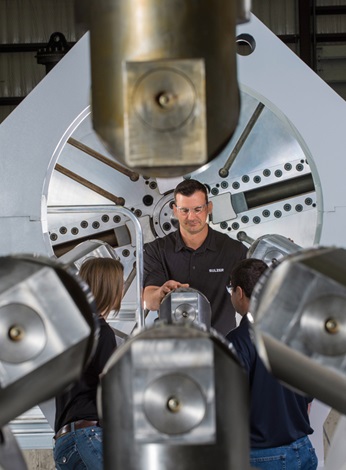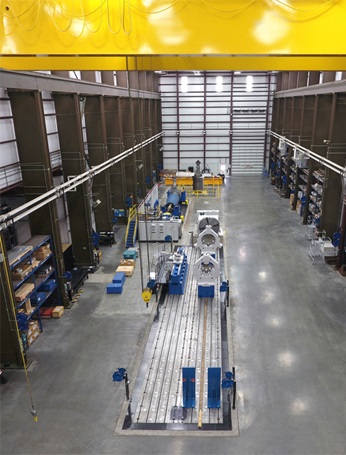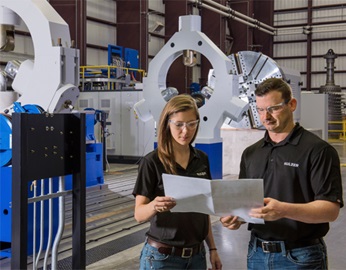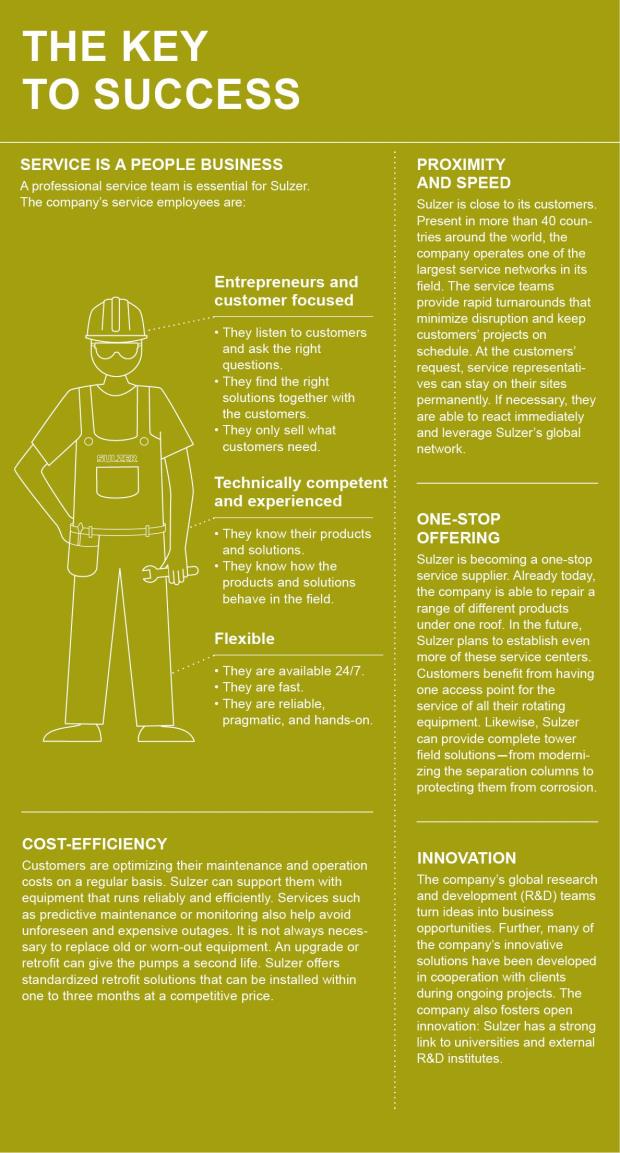Service Excellence Through Innovation
Core Competencies: Repairing the World’s Largest Industrial Gas Turbines
Imagine a hall the size of one and a half football fields. After stepping through the giant gate and looking inside, you see a massive crane that can lift compressor and turbine sections 50 meters into the air. Looking around, you see a balancing machine, capable of balancing rotors that weigh up to 82 tons. In comparison, a five-ton African elephant, the heaviest living land animal in the world, is a lightweight. There is another impressive machine that spans across more than 20 meters. It is a state-of-the-art, versatile lathe that was built to accommodate large gas turbine rotors with a capacity of 90 tons.
The plant where all this is set up is called Big Bay 3. Big Bay 3 is part of Sulzer’s Houston Service Center located in La Porte, Texas, USA. At 25 700 m2, it is the company’s largest facility for rotating equipment repair. The Houston Service Center specializes in maintenance and repairs of all makes and models of turbomachinery.
Bigger turbines to satisfy increasing demand
The global energy demand is increasing. This puts the power generation industry under pressure to produce more energy in a more efficient way. As a result, industrial gas turbines are becoming bigger and bigger, and their technology has significantly developed over the last 50 years. Manufacturers are compelled to develop much larger turbines designed for uninterrupted operations.
From natural gas to energy
Gas turbines are used in power plants to convert natural gas into mechanical energy. This energy drives a generator that produces electrical energy. Power lines then transport the energy to homes and businesses.
In a gas turbine, air enters the compressor section that is made up of numerous blades. As the rotor turns, the air runs through the blades and is compressed. This compressed air then enters the combustion section and is mixed with a fuel such as natural gas or fuel oil. It is then ignited in the combustion section, and travels as hot gas into the turbine section. The hot gas moves through blades in the turbine and causes them to spin. Because the turbine is coupled to a generator, this rotation drives the generator. The generator then converts the mechanical energy into electricity (watch the gas turbine animation here).
Suitable equipment to handle large refurbishment projects
Industrial gas turbines that operate in these environments require periodic repairs. Turbine operators need a one-stop service facility where maintenance providers are able to deliver a complete repair. The massive size of modern, industrial gas turbine rotors means that a repair facility must be equipped with cutting-edge equipment capable of lifting, balancing, and machining a fully assembled rotor. Having the appropriate large-scale equipment to handle these turbine rotor refurbishments is critical to the processes and workflow involved in the repair process. In the past, cranes and lathes that could accommodate approximately 55 tons were adequate, but as the output capacity of industrial gas turbines has increased, so has the weight of the rotors. With Big Bay 3, Sulzer is one of a handful of service suppliers who has the equipment and expertise to service such large machines.
How do you repair a gas turbine that weighs 80 tons?
In heavy industrial machines such as gas turbines and electric generators, vibration is a frequent problem, because it can cause catastrophic failure and noise. By repairing and balancing the rotor, vibration can be avoided. But how do you repair a gas turbine rotor that can easily weigh as much as 16 elephants?
The repair process begins with the inspection of the rotor using the balance machine. This machine can identify any unbalance issues. After the initial balance run, the rotor is then placed into V-blocks (runout stands) and is rotated. This allows the service employee to inspect the rotor critically. Based on these first inspections, engineers decide if the rotor needs to be disassembled.
If this should be the case, it is placed in a stacking pit. For this, a large crane is necessary. Once the rotor is disassembled, the service team inspects the individual components of the respective compressor or turbine parts. Each part is thoroughly examined and inspected in detail for reuse or specialized repairs (such as replacing blades or coating compressor disks). The individual disks go through concentricity checks and are balanced in a horizontal balance stand before being reassembled. After the individual components are qualified, each section is dynamically balanced and prepared for assembly. After reassembly, the compressor section and the turbine section are placed in the lathe to check runouts and correct the rotor if necessary. Each rotor section is then rechecked for balance before it returns to the stacking pit where the major sections are mated. The complete rotor is then ready for final checks and dynamic balancing before being shipped back to the customer.
Minimizing downtime and cost
For the customer, speed of repair and minimizing downtime is crucial. With suitable shop facilities and equipment, it is a relatively straightforward task to deal with a single rotor. Coordinating the repairs to multiple rotors and minimizing the time between each stage is a more complicated issue. Today’s repair specialists use systematic planning, have excellent project management skills, and possess a range of versatile equipment to deliver cost-effective, timely, and successful projects.
Over the past year, Sulzer has provided services for around 70 gas turbines in its La Porte facility. Roughly 30 service employees ensure that these large projects are carried out in a timely and cost-effective manner.
"The mechanics in Big Bay 3 are true jacks-of-all-trades"
Jennifer Gaines from Houston, TX, USA, used to work as a production engineer in Big Bay 3 (BB3). She has spent the last couple of years dedicating her career to the repair and maintenance of massive equipment in the gigantic shop. Recently, she was promoted to mechanical design engineer in Sulzer’s core engineering group. As one of Sulzer’s female engineers, she looks back at her experience in BB3 with pleasure:
"Repairing these large industrial gas turbines is hard work and requires extreme care. You have to ensure an efficient workflow to get the job done as quickly but, at the same time, as diligently as possible. With this type of heavy-duty equipment, every hour these machines are not in service equates to enormous amounts of dollars and production hours lost."
She particularly appreciated the high level of technical experience in the BB3 team. "The mechanics and machinists in BB3 can perform all of the requirements and are truly jacks-of-all-trades. I thoroughly enjoyed working with the team. I look forward to utilizing the valuable skills gained from BB3 in my new job at Sulzer."
Jennifer Gaines’ career with Sulzer began with a rigorous program that encompassed hands-on training on the shop floor. There, she worked directly with equipment and highly experienced maintenance mechanics and machinists. Once her training on the shop floor was complete, she transitioned to providing cutting-edge engineering services. As part of this, she designed specialized shop tools and solutions to help the mechanics better disassemble, inspect, repair, and assemble equipment.
Boosting Energy Efficiency by up to 50% in 36 Hours
Many wastewater treatment plants are aging. Hence, operators not only experience growing operating costs, but also face the risk of equipment failure. The failure of a single blower or compressor may jeopardize the functioning of the entire wastewater treatment plant. With the recently launched fast-track process, Sulzer can ship its highly efficient HST turbocompressors to a plant within 36 hours and help boost energy efficiency by up to 50%.
Back in operation and more efficient than before
Old blowers and compressors consume a large part of the total energy of a wastewater treatment plant. One option is to repair or replace them one for one with the same make and model. The other, more economic option is to replace them with the Sulzer HST turbocompressor. This compressor type reduces the energy costs for aeration by up to 50% and offers a payback as short as two years.
From Finland to Switzerland in less than two days
ERZO, a waste disposal company in Switzerland, required an update of the electronics of an HST turbocompressor that has been in operation for almost 20 years. Lately, the operator had to switch to manual use on a regular basis to ensure sufficient air supply for the biological process of the facility. Initially, the operator planned to update the turbocompressor with a new electronic system. Because of Sulzer’s fast-track process, the customer decided to replace the old turbocompressor. Within 36 hours, Sulzer delivered its HST compressor from its factory in Finland to Switzerland and installed it at the customer’s plant. Adrian Burkart, Division Manager ARA ERZO, said, “Thanks to the fast replacement, we were able to ensure efficiency and environmental water protection within 36 hours.”



